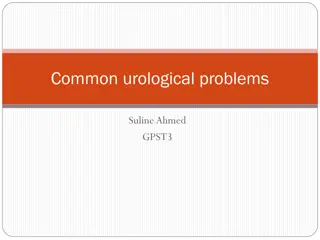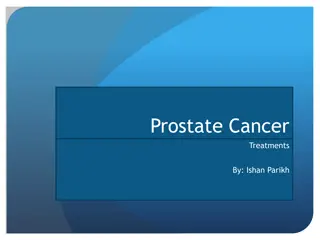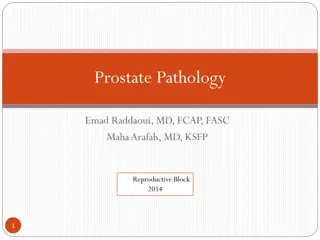
Benign Prostatic Hyperplasia (BPH) in a 67-Year-Old Male
Explore the case of a 67-year-old male with Benign Prostatic Hyperplasia (BPH), experiencing difficulty urinating that has worsened over time. Learn about his medical history, medications, social habits, and overall health assessment.
Download Presentation

Please find below an Image/Link to download the presentation.
The content on the website is provided AS IS for your information and personal use only. It may not be sold, licensed, or shared on other websites without obtaining consent from the author. If you encounter any issues during the download, it is possible that the publisher has removed the file from their server.
You are allowed to download the files provided on this website for personal or commercial use, subject to the condition that they are used lawfully. All files are the property of their respective owners.
The content on the website is provided AS IS for your information and personal use only. It may not be sold, licensed, or shared on other websites without obtaining consent from the author.
E N D
Presentation Transcript
BPH: Benign Prostatic Hyperplasia DACY GASTON
BPH Chief Complaint: I ve been having difficulty urinating. HPI: Patient D.W. is a 67 year old Caucasian male that presents to the clinic with complaints of difficulty while trying to void. It has been getting worse over the last year, and it has gotten to the point where it is waking him up 2-3 times during the night. He also states that when he gets up to void, only a small amount of urine is produced.
BPH PMH: * Diabetes Type II diagnosed 2009 * Hypertension diagnosed 2006 * Hyperlipidemia diagnosed 2006 Family History: Father: CAD, Diabetes, BPH Mother: Diabetes, HTN
BPH Medications: 1) HCTZ 25 mg PO daily 2) Lipitor 20 mg PO daily 3) Metformin 500mg PO BID Allergies: NKDA Surgical History: Gallbladder removal 2000 unremarkable
BPH Social History: Denies recreational drug use. Has type 2 Diabetes managed by Metformin. His sugars run 120-150 in the morning. He drinks 2 glasses of wine a night. Does not exercise regularly but tries to eat a healthy diet but states it is hard to when he works long hours on the job. Works as a construction worker with long hours and outside labor. Lives with his wife of 35 years. Has no children.
BPH ROS General: denies fever, chills, or headache fatigue. HEENT: denies headaches, dizziness, vertigo, fainting or trauma. Last eye Exam was 6 months ago-normal. Denies changes in vision, pain, redness, double vision or discharge. Denies hearing impairment, tinnitus, earaches or infection. Seasonal allergies with nasal congestion, otherwise denies discharge, infection, nosebleeds or trauma. Last dental exam 6 months ago, cavity filling, otherwise denies sore throat, voice changes, bleeding gums or hoarseness
BPH Skin: denies rash, itching, tingling, lesions or wounds. Neck: denies dysphagia, tenderness, pain, or masses Pulmonary: Denies dyspnea, cough, sputum, hemoptysis, wheezing or asthma. Cardiovascular: Denies palpitations, orthopnea, edema or murmurs. Gastrointestinal: denies reflux, vomiting. No change in stool pattern, denies blood- tinged stools, abdominal pain, constipation or diarrhea. Extremities: Denies coolness, tingling, loss of sensation or cyanosis. Vascular: Denies leg pain, swelling, leg cramps, ulcers or loss of hair on legs. Urinary: SEE HPI Musculoskeletal: Denies muscle or joint pain/tenderness/stiffness, muscle cramps, gout or weakness. Full ROM. Neurological: Denies fainting, blackouts, weakness, paralysis, numbness, tremors, loss of memory, unsteady gait or speech disorders. Endocrine: Denies thyroid disorder, heat or cold intolerance, changes in hair growth.
BPH Objective Physical Exam: Vital Signs: BP 145/92 - HR 63 regular- RR 20 unlabored- Temp 98.7 O2 98% Height: 5ft 10inches Weight: 242 BMI: 34.7-obese General: Patient is overweight Caucasian male who appears moderately distressed at this time. He is AOx3, appropriately dressed and aware of his situation and surroundings
BPH HEENT: Head nomocephalic without tinderness, lesions or lumps. Hair evenly distributed, texture and quantity unremarkable. Facial features symmetrical an overall unremarkable, no weakness noted. PERRLA, EOM intact, Sclera clear, no redness or lesions present, conjunctiva pink without excessive vascularity. Cornea clear, no discharge or excessive tearing. Ear canals clear, no lesions or tenderness noted. Tympanic membranes bilaterally pearly gray with light reflex. No external exudate or bleeding. Rhinne: AC>BC bilateral. Webber: midline no lateralization. Nose symmetrical with no evidence of trauma. Nares patent, mucosa pink without discharge or swelling. Mouth mucosa moist, pink without lesions, tongue is midline, no coating or swelling present. Throat is moist, pink, uvula rises midline symmetrically with mild obstruction of uvula, gag reflex intact.
BPH Neck: Full ROM, trachea midline, thyroid unremarkable, no lymphadenopathy. Skin: Somewhat flushed on face and cheeks, mild diaphoresis noted on forehead and palms of hands. Cool and clammy to touch, turgor good, nail beds pink with good capillary refill. Pulmonary: Lungs clear bilaterally, no crackles, ronchi, wheezing or rales. Unlabored symmetrical respirations. Tactile fremitus normal intensity and equal bilaterally. Percussion resonant in all lung fields. Vesicular breath sounds heard throughout. No egophony, whispered pectoriloquy or broncophony noted Cardiovascular: Examined seated and supine. No abnormal pulsations, thrills or heaves noted. S1 louder at apex, S2 louder at base. No extra heart sounds heard, no murmurs, rub or gallop.
BPH Vascular: No JVD. All pulses 2+ bilaterally in upper and lower extremities. No bruits heard. Negative Homan s sign bilaterally. Abdomen: Obese abdomen otherwise unremarkable to inspection, no visual abdominal pulsations. Normoactive bowel sounds in all 4 quadrants. Percussion dull from extra abdominal fat but noted throughout. Liver span normal, no organomegaly noted. No masses noted. No CVA tenderness noted. No bruit heard over aortic umbilicus. Scar noted from gallbladder removal, otherwise unremarkable. Genitourinary: DRE shows slightly larger than normal prostate margins, with mild hardening of the prostate. Extremities: Capillary refill <1 second, no edema, no clubbing noted. Full ROM bilateral upper/lower extremity. Musculoskeletal: Gain within normal limits, full ROM all extremities. Spine midline with no deviation, normal curvature. No joint or muscle pain. Neurological: AOx3 with no mental deficits noted. Cranial nerves intact. DTR s intact, 2+ upper and lower extremities. Sensory intact, no motor deficits noted. Gait normal
BPH Differential/Diagnosis: 1) BPH: ICD-9 600.0 : Benign prostatic hyperplasia (BPH) is an histologic diagnosis that refers to the proliferation of smooth muscle and epithelial cells within the prostatic transition zone (Gacci, et. al, 2014) 2) Cystitis ICD-9 599.0 3) Prostate Cancer ICD-9 185 4) Overactive Bladder ICD-9 596.51
BPH Plan 1) DRE-Done in Pt. assessment-feels abnormal. The DRE and the abnormal prostate findings will need to be further worked up for Blood Test-PSA (American Urological Association, 2010). 2) Blood PSA test- In patients with bothersome symptoms, it is now recognized that LUTS has a number of causes that may occur singly or in combination. Among the most important are BPO, overactive bladder, and nocturnal polyuria (American Urological Association, 2010). 4) Watchful Waiting-Patients with mild symptoms of LUTS secondary to BPH (AUA-SI score <8) and patients with moderate or severe symptoms (AUA-SI score 8) who are not bothered by their LUTS should be managed using a strategy of watchful waiting (AUA, 2010) 3) Referral to Urology-If the initial evaluation demonstrates the presence of LUTS associated with results of a digital rectal exam (DRE) suggesting prostate cancer, hematuria, abnormal prostate-specific antigen (PSA) levels, recurrent infection, palpable bladder, history/risk of urethral stricture, and/or a neurological disease raising the likelihood of a primary bladder disorder, the patient should be referred to a urologist for appropriate evaluation before advising treatment (AUA, 2010)
BPH References: American Urological Association. (2010). Guidelines: BPH Management. Retrieved from https://www.auanet.org/education/guidelines/benign-prostatic- hyperplasia.cfm Bradway, C., Bixby, M. B., Hirschman, K. B., McCauley, K., & Naylor, M. D. (2013). Case Study: Transitional Care For a Patient with Benign Prostatic Hyperplasia and Recurrent Urinary Tract Infections. Urologic Nursing, 33(4), 177-200. Gacci, M., Carini, M., Salvi, M., Sebastianelli, A., Vignozzi, L., Corona, G., & ... Serni, S. (2014). Management of Benign Prostatic Hyperplasia: Role of Phosphodiesterase-5 Inhibitors. Drugs & Aging, 31(6), 425-439.




